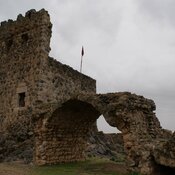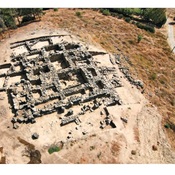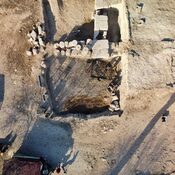Es gibt noch keine deutschsprachige Anmerkungen. Präsentiert wirden Anmerkungen auf English.
The Hemite Relief (Hamide) (close to the village of Hemite/Hamide) is a rock relief 1.75m. height. It is carved on the steep rocky surface facing east, on the banks of the Ceyhan river. It was first noticed by H. Bossert in 1946, but the first detailed study was done by Alfonso Archi. It shows great similarities with the Hanyeri relief. It displays a warrior facing left with a spear in his right hand and a bow on his left shoulder.and diagonally hanging sword with a crescent hilt,. Its round head, earrings and pointed shoes are similar to the monuments in Hanyeri and Sirkeli. The two-line inscription next to it reads as “Prince …-Tarhunta, son of Prince Tarhuntapiya(?)”. It is dated to the 13th century BC.
Sources:
- Kurt Bitel, Les Hittites, Gallimard, Paris 1987, pp. 14, 180, 184, fig. 202
- Horst Ehringhaus: Götter, Herrscher, Inschriften. Die Felsreliefs der hethitischen Großreichszeit in der Türkei, Zabern, Mainz, 2005, pp. 107–111.
- Kay Kohlmeyer: Felsbilder der hethitischen Großreichszeit. In: Acta Praehistorica et Archaeologica 15 (1983), pp. 90–95.
- http://www.hittitemonuments.com/hemite/
The Hemite Relief (Hamide) (close to the village of Hemite/Hamide) is a rock relief 1.75m. height. It is carved on the steep rocky surface facing east, on the banks of the Ceyhan river. It was first noticed by H. Bossert in 1946, but the first detailed study was done by Alfonso Archi. It shows great similarities with the Hanyeri relief. It displays a warrior facing left with a spear in his right hand and a bow on his left shoulder.and diagonally hanging sword with a crescent hilt,. Its round head, earrings and pointed shoes are similar to the monuments in Hanyeri and Sirkeli. The two-line inscription next to it reads as “Prince …-Tarhunta, son of Prince Tarhuntapiya(?)”. It is dated to the 13th century BC.
Sources:
- Kurt Bitel, Les Hittites, Gallimard, Paris 1987, pp. 14, 180, 184, fig. 202
- Horst Ehringhaus: Götter, Herrscher, Inschriften. Die Felsreliefs der hethitischen Großreichszeit in der Türkei, Zabern, Mainz, 2005, pp. 107–111.
- Kay Kohlmeyer: Felsbilder der hethitischen Großreichszeit. In: Acta Praehistorica et Archaeologica 15 (1983), pp. 90–95.
- http://www.hittitemonuments.com/hemite/





